+ Open data
Open data
- Basic information
Basic information
| Entry | Database: PDB / ID: 6oya | ||||||||||||
|---|---|---|---|---|---|---|---|---|---|---|---|---|---|
| Title | Structure of the Rhodopsin-Transducin-Nanobody Complex | ||||||||||||
 Components Components |
| ||||||||||||
 Keywords Keywords | SIGNALING PROTEIN/IMMUNE SYSTEM / GPCR / G protein / Complex / SIGNALING PROTEIN-IMMUNE SYSTEM complex | ||||||||||||
| Function / homology |  Function and homology information Function and homology informationnegative regulation of cyclic-nucleotide phosphodiesterase activity / Opsins / VxPx cargo-targeting to cilium / sperm head plasma membrane / rod bipolar cell differentiation / absorption of visible light / opsin binding / The canonical retinoid cycle in rods (twilight vision) / G protein-coupled opsin signaling pathway / photoreceptor inner segment membrane ...negative regulation of cyclic-nucleotide phosphodiesterase activity / Opsins / VxPx cargo-targeting to cilium / sperm head plasma membrane / rod bipolar cell differentiation / absorption of visible light / opsin binding / The canonical retinoid cycle in rods (twilight vision) / G protein-coupled opsin signaling pathway / photoreceptor inner segment membrane / Olfactory Signaling Pathway / podosome assembly / G protein-coupled photoreceptor activity / Sensory perception of sweet, bitter, and umami (glutamate) taste / 11-cis retinal binding / Synthesis, secretion, and inactivation of Glucagon-like Peptide-1 (GLP-1) / rod photoreceptor outer segment / cellular response to light stimulus / detection of light stimulus involved in visual perception / eye photoreceptor cell development / G protein-coupled receptor complex / Inactivation, recovery and regulation of the phototransduction cascade / thermotaxis / Activation of the phototransduction cascade / outer membrane / detection of temperature stimulus involved in thermoception / response to light intensity / photoreceptor cell maintenance / arrestin family protein binding / Activation of G protein gated Potassium channels / G-protein activation / G beta:gamma signalling through PI3Kgamma / Prostacyclin signalling through prostacyclin receptor / G beta:gamma signalling through PLC beta / ADP signalling through P2Y purinoceptor 1 / Thromboxane signalling through TP receptor / Presynaptic function of Kainate receptors / G beta:gamma signalling through CDC42 / Inhibition of voltage gated Ca2+ channels via Gbeta/gamma subunits / G alpha (12/13) signalling events / Glucagon-type ligand receptors / G beta:gamma signalling through BTK / ADP signalling through P2Y purinoceptor 12 / Adrenaline,noradrenaline inhibits insulin secretion / Cooperation of PDCL (PhLP1) and TRiC/CCT in G-protein beta folding / Ca2+ pathway / Thrombin signalling through proteinase activated receptors (PARs) / G alpha (z) signalling events / Extra-nuclear estrogen signaling / photoreceptor outer segment membrane / G alpha (s) signalling events / G alpha (q) signalling events / G alpha (i) signalling events / Glucagon-like Peptide-1 (GLP1) regulates insulin secretion / High laminar flow shear stress activates signaling by PIEZO1 and PECAM1:CDH5:KDR in endothelial cells / Vasopressin regulates renal water homeostasis via Aquaporins / acyl binding / response to light stimulus / phototransduction, visible light / G-protein alpha-subunit binding / phototransduction / photoreceptor outer segment / sperm midpiece / photoreceptor inner segment / visual perception / guanyl-nucleotide exchange factor activity / G protein-coupled receptor binding / adenylate cyclase-modulating G protein-coupled receptor signaling pathway / microtubule cytoskeleton organization / G-protein beta/gamma-subunit complex binding / photoreceptor disc membrane / GDP binding / cell-cell junction / cellular response to catecholamine stimulus / adenylate cyclase-activating dopamine receptor signaling pathway / intracellular protein localization / cellular response to prostaglandin E stimulus / G-protein beta-subunit binding / heterotrimeric G-protein complex / sensory perception of taste / signaling receptor complex adaptor activity / retina development in camera-type eye / GTPase binding / phospholipase C-activating G protein-coupled receptor signaling pathway / gene expression / cell population proliferation / G protein-coupled receptor signaling pathway / Golgi membrane / GTPase activity / synapse / protein kinase binding / GTP binding / protein-containing complex binding / zinc ion binding / metal ion binding / identical protein binding / membrane / plasma membrane / cytoplasm Similarity search - Function | ||||||||||||
| Biological species |   | ||||||||||||
| Method | ELECTRON MICROSCOPY / single particle reconstruction / cryo EM / Resolution: 3.3 Å | ||||||||||||
 Authors Authors | Gao, Y. / Hu, H. / Ramachandran, S. / Erickson, J.W. / Cerione, R.A. / Skiniotis, G. | ||||||||||||
| Funding support |  United States, 3items United States, 3items
| ||||||||||||
 Citation Citation |  Journal: Mol Cell / Year: 2019 Journal: Mol Cell / Year: 2019Title: Structures of the Rhodopsin-Transducin Complex: Insights into G-Protein Activation. Authors: Yang Gao / Hongli Hu / Sekar Ramachandran / Jon W Erickson / Richard A Cerione / Georgios Skiniotis /  Abstract: Rhodopsin (Rho), a prototypical G-protein-coupled receptor (GPCR) in vertebrate vision, activates the G-protein transducin (G) by catalyzing GDP-GTP exchange on its α subunit (Gα). To elucidate the ...Rhodopsin (Rho), a prototypical G-protein-coupled receptor (GPCR) in vertebrate vision, activates the G-protein transducin (G) by catalyzing GDP-GTP exchange on its α subunit (Gα). To elucidate the determinants of G coupling and activation, we obtained cryo-EM structures of a fully functional, light-activated Rho-G complex in the presence and absence of a G-protein-stabilizing nanobody. The structures illustrate how G overcomes its low basal activity by engaging activated Rho in a conformation distinct from other GPCR-G-protein complexes. Moreover, the nanobody-free structures reveal native conformations of G-protein components and capture three distinct conformers showing the Gα helical domain (αHD) contacting the Gβγ subunits. These findings uncover the molecular underpinnings of G-protein activation by visual rhodopsin and shed new light on the role played by Gβγ during receptor-catalyzed nucleotide exchange. | ||||||||||||
| History |
|
- Structure visualization
Structure visualization
| Movie |
 Movie viewer Movie viewer |
|---|---|
| Structure viewer | Molecule:  Molmil Molmil Jmol/JSmol Jmol/JSmol |
- Downloads & links
Downloads & links
- Download
Download
| PDBx/mmCIF format |  6oya.cif.gz 6oya.cif.gz | 200.6 KB | Display |  PDBx/mmCIF format PDBx/mmCIF format |
|---|---|---|---|---|
| PDB format |  pdb6oya.ent.gz pdb6oya.ent.gz | 153.8 KB | Display |  PDB format PDB format |
| PDBx/mmJSON format |  6oya.json.gz 6oya.json.gz | Tree view |  PDBx/mmJSON format PDBx/mmJSON format | |
| Others |  Other downloads Other downloads |
-Validation report
| Summary document |  6oya_validation.pdf.gz 6oya_validation.pdf.gz | 975.6 KB | Display |  wwPDB validaton report wwPDB validaton report |
|---|---|---|---|---|
| Full document |  6oya_full_validation.pdf.gz 6oya_full_validation.pdf.gz | 984.3 KB | Display | |
| Data in XML |  6oya_validation.xml.gz 6oya_validation.xml.gz | 33.8 KB | Display | |
| Data in CIF |  6oya_validation.cif.gz 6oya_validation.cif.gz | 51.1 KB | Display | |
| Arichive directory |  https://data.pdbj.org/pub/pdb/validation_reports/oy/6oya https://data.pdbj.org/pub/pdb/validation_reports/oy/6oya ftp://data.pdbj.org/pub/pdb/validation_reports/oy/6oya ftp://data.pdbj.org/pub/pdb/validation_reports/oy/6oya | HTTPS FTP |
-Related structure data
| Related structure data |  20223MC  6oy9C M: map data used to model this data C: citing same article ( |
|---|---|
| Similar structure data |
- Links
Links
- Assembly
Assembly
| Deposited unit | 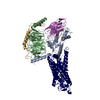
|
|---|---|
| 1 |
|
- Components
Components
-Protein , 2 types, 2 molecules AR
| #1: Protein | Mass: 41175.715 Da / Num. of mol.: 1 Source method: isolated from a genetically manipulated source Source: (gene. exp.)   |
|---|---|
| #5: Protein | Mass: 39031.457 Da / Num. of mol.: 1 / Source method: isolated from a natural source / Source: (natural)  |
-Guanine nucleotide-binding protein ... , 2 types, 2 molecules BG
| #2: Protein | Mass: 37430.957 Da / Num. of mol.: 1 / Source method: isolated from a natural source / Source: (natural)  |
|---|---|
| #3: Protein | Mass: 9337.784 Da / Num. of mol.: 1 / Source method: isolated from a natural source / Source: (natural)  |
-Antibody / Non-polymers , 2 types, 2 molecules N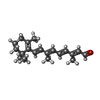

| #4: Antibody | Mass: 15052.680 Da / Num. of mol.: 1 Source method: isolated from a genetically manipulated source Source: (gene. exp.)   |
|---|---|
| #6: Chemical | ChemComp-RET / |
-Details
| Has protein modification | Y |
|---|
-Experimental details
-Experiment
| Experiment | Method: ELECTRON MICROSCOPY |
|---|---|
| EM experiment | Aggregation state: PARTICLE / 3D reconstruction method: single particle reconstruction |
- Sample preparation
Sample preparation
| Component |
| ||||||||||||||||||||||||||||||
|---|---|---|---|---|---|---|---|---|---|---|---|---|---|---|---|---|---|---|---|---|---|---|---|---|---|---|---|---|---|---|---|
| Molecular weight | Value: 0.1418 MDa / Experimental value: NO | ||||||||||||||||||||||||||||||
| Source (natural) |
| ||||||||||||||||||||||||||||||
| Source (recombinant) |
| ||||||||||||||||||||||||||||||
| Buffer solution | pH: 7.5 | ||||||||||||||||||||||||||||||
| Specimen | Embedding applied: NO / Shadowing applied: NO / Staining applied: NO / Vitrification applied: YES | ||||||||||||||||||||||||||||||
| Specimen support | Grid material: GOLD / Grid mesh size: 200 divisions/in. / Grid type: Quantifoil R1.2/1.3 | ||||||||||||||||||||||||||||||
| Vitrification | Instrument: FEI VITROBOT MARK III / Cryogen name: ETHANE / Humidity: 100 % Details: Blot for 1 second before plunging; avoid light as much as possible. |
- Electron microscopy imaging
Electron microscopy imaging
| Experimental equipment |  Model: Titan Krios / Image courtesy: FEI Company |
|---|---|
| Microscopy | Model: FEI TITAN KRIOS |
| Electron gun | Electron source:  FIELD EMISSION GUN / Accelerating voltage: 300 kV / Illumination mode: FLOOD BEAM FIELD EMISSION GUN / Accelerating voltage: 300 kV / Illumination mode: FLOOD BEAM |
| Electron lens | Mode: BRIGHT FIELD / Cs: 2.7 mm / C2 aperture diameter: 50 µm |
| Image recording | Electron dose: 40 e/Å2 / Detector mode: COUNTING / Film or detector model: GATAN K2 SUMMIT (4k x 4k) / Num. of real images: 3837 |
| EM imaging optics | Energyfilter name: GIF Quantum LS / Energyfilter slit width: 20 eV |
| Image scans | Movie frames/image: 40 |
- Processing
Processing
| EM software |
| ||||||||||||||||||||
|---|---|---|---|---|---|---|---|---|---|---|---|---|---|---|---|---|---|---|---|---|---|
| CTF correction | Type: PHASE FLIPPING AND AMPLITUDE CORRECTION | ||||||||||||||||||||
| Symmetry | Point symmetry: C1 (asymmetric) | ||||||||||||||||||||
| 3D reconstruction | Resolution: 3.3 Å / Resolution method: FSC 0.143 CUT-OFF / Num. of particles: 309116 / Symmetry type: POINT | ||||||||||||||||||||
| Atomic model building | Protocol: BACKBONE TRACE |
 Movie
Movie Controller
Controller




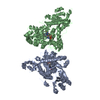

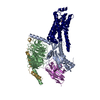
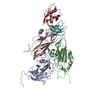

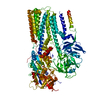

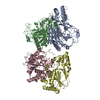

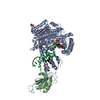
 PDBj
PDBj













